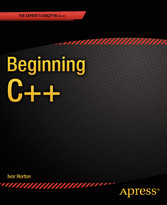Suchen und Finden
Beginning C++
Beginning C++ is a tutorial for beginners in C++ and discusses a subset of C++ that is suitable for beginners. The language syntax corresponds to the C++14 standard. This book is environment neutral and does not presume any specific operating system or program development system. There is no assumption of prior programming knowledge.
All language concepts that are explained in the book are illustrated with working program examples. Most chapters include exercises for you to test your knowledge. Code downloads are provided for examples from the text and solutions to the exercises and there is an additional download for a more substantial project for you to try when you have finished the book.
This book introduces the elements of the C++ standard library that provide essential support for the language syntax that is discussed. While the Standard Template Library (STL) is not discussed to a significant extent, a few elements from the STL that are important to the notion of modern C++ are introduced and applied.
Beginning C++ is based on and supersedes Ivor Horton’s previous book, Beginning ANSI C++.
Ivor Horton is self-employed in consultancy and writes programming tutorials. He worked for IBM for many years and holds a bachelor's degree, with honors, in mathematics. Horton's experience at IBM includes programming in most languages (like assembler and high-level languages on a variety of machines), real-time programming, and designing and implementing real-time closed loop industrial control systems. He has extensive experience teaching programming to engineers and scientists (Fortran, PL/1, APL, etc.). Horton is an expert in mechanical, process, and electronic CAD systems; mechanical CAM systems; and DNC/CNC systems.
Alle Preise verstehen sich inklusive der gesetzlichen MwSt.









